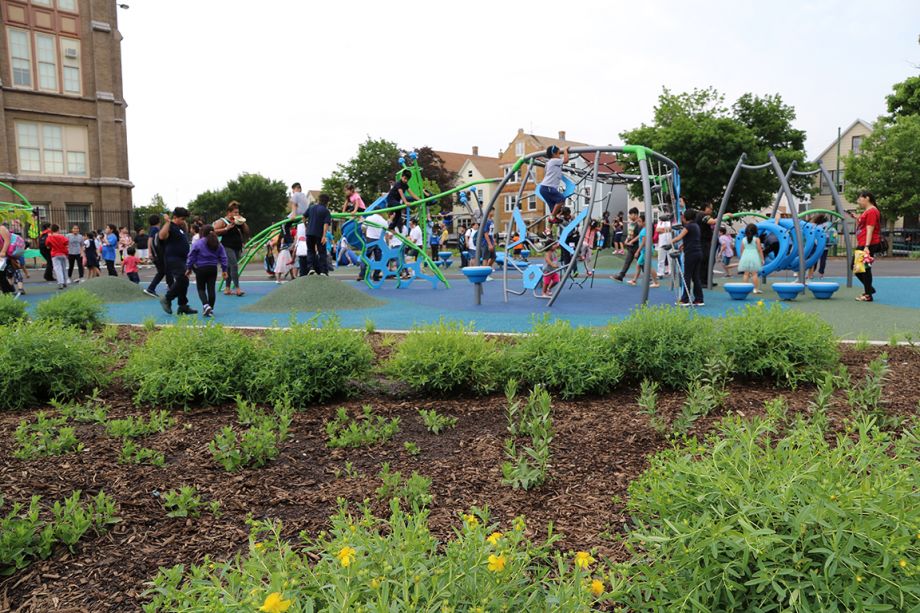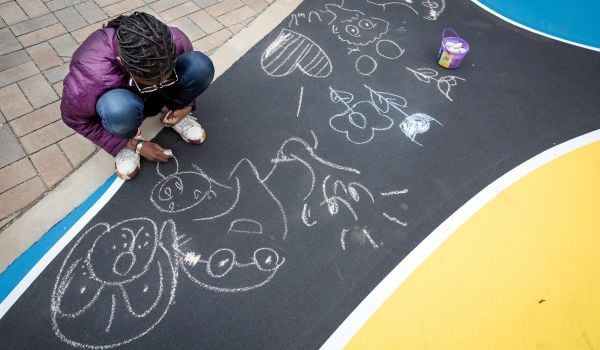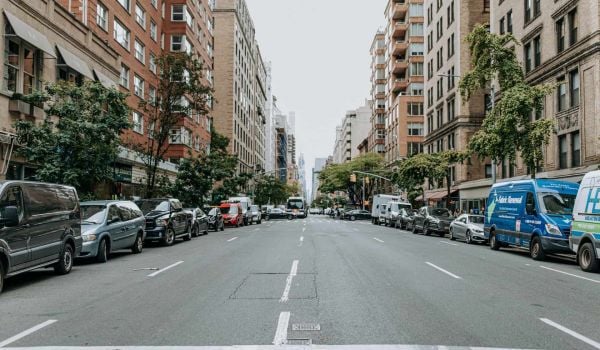Harold Washington Elementary School in the Burnside neighborhood on the south side of Chicago got a new schoolyard in 2020. It features a running track, sports fields and playground equipment — but what Washington’s Principal Sherri Walker likes best are the little conversational groupings of rocks. “It’s so special for the older girls,” Walker says. “They don’t always want to play on the equipment or play sports — but they sit on those rocks and talk. It becomes a quiet space where they can sit and decompress.” In a year with so much stress and loss, especially in Chicago’s most underinvested neighborhoods, these spaces are invaluable.
Principal Walker’s schoolyard is part of a program called Space to Grow, which turns Chicago schoolyards into beautiful green spaces for play and learning using green stormwater infrastructure that also helps build climate resilience. The schoolyards include playground structures and sports fields, outdoor classrooms for nature-based learning, edible gardens and the conversation rocks or other quiet spaces the students at Washington like so much. Studies show that access to green space and outdoor play during the school day are associated with improved focus and academic performance. Daily connection with nature supports mental health. And, since Space to Grow schoolyards are also open to the community outside of school hours, the program’s benefits aren’t just limited to students.
It seems obvious that every student should have access to such a positive space, but there just isn’t enough money — or the will to prioritize spending — to replace the acres of asphalt that cover school grounds in many cities across the country. A 2021 report on the state of U.S. schools found that the country is underinvesting in school buildings and grounds to the tune of $85 billion per year. “Underinvestment in capital renewals of existing public schools as well as chronic underfunding of maintenance and repairs sadly remains the rule rather than the exception,” the report notes. And, as the report also points out, “inequity is hard-wired into public education infrastructure.” For example, in Chicago, the same Black and Latinx neighborhoods are subjected to the same type of disinvestment over and over again.
Green schoolyard programs like Space to Grow can be an innovative solution. The program was developed in response to a need raised by school staff and partners after parent leaders successfully advocated for the return of daily recess and stronger PE programs in Chicago Public Schools in 2011. Many of the school district’s 400 elementary schools had unsafe asphalt lots, inadequate for supporting vibrant recess and PE programs, and the district was in financial crisis.
At the same time, the city’s water agencies — Metropolitan Water Reclamation District of Greater Chicago (MWRD) and the Chicago Department of Water Management (DWM) — were initiating major investments in green stormwater infrastructure to combat Chicago’s persistent flooding issues and build climate resilience. Space to Grow’s nonprofit managing partners, Healthy Schools Campaign and Openlands, came together with these public water agencies and the school district to develop a vision for green schoolyards across Chicago that would not only manage significant amounts of stormwater, but also provide outdoor learning, play, gardening and community recreation opportunities. The three public agency partners made an initial investment of $51 million to transform 34 schoolyards.
Space to Grow schoolyards are prioritized in Chicago’s historically underinvested communities that tend to lack safe, shared green space and whose schools primarily serve Black and Latinx students. The Space to Grow partners use an equity lens to select school sites, considering factors such as income, race/ethnicity, community hardship index, historical capital investments and community life expectancy.
The innovative partnership is built on the idea that capital improvement is just the first step in creating a lasting community asset. The nonprofit managing partners oversee an inclusive planning process that engages the entire community at every Space to Grow school. Space to Grow outreach staff work with each selected school to form a committee that supports the schoolyard planning and outreach efforts and helps the partners develop deep community relationships. The committee includes representatives for students, staff, parents, neighbors and the broader community, and leverages relationships with local community-based organizations, strengthening their relationship with the local school. In multilingual communities, the outreach and meeting materials are translated, and meetings are interpreted for all primary languages of each community. The process gives a meaningful voice to community members who traditionally have had little voice in this type of decision-making process.
The process is empowering. As Sharon Mason, a teacher at Mays Academy puts it, “many of our students in the Englewood area are exposed daily to trauma that stems not only from violence, but poverty, drug addiction, experiencing racism and a sense of loss of self. The process of involving students in the design gives them a sense of their own agency.”
Even after the schoolyard is complete, Space to Grow partners continue to engage and support the school community through workshops, trainings, partnerships with community-based organizations, events and technical assistance, all of which are designed to ensure community members feel welcomed at the schoolyards and feel ownership to use the space. The partners train school staff to leverage the schoolyard for physical activity, nutrition education, nature-based education and outdoor learning. The partners also educate neighbors and school stakeholders about gardening, tree planting and stormwater management practices.
The outcome is that each Space to Grow schoolyard is a powerful school and community resource. As Dr. Rashid Shabazz, principal of Wadsworth STEM in Chicago’s Woodlawn community explains, the schoolyard is used not only during the day for PE classes, recess, learning about gardening and “brain breaks” during the school day, but also by the community around the clock. People see it as a safe space in the neighborhood,” he says.
Space to Grow shows how cities and communities across the country can engage in unique partnerships to generate multiple positive impacts, providing a return on investment that supports schools and communities in a holistic way. The next step is to make green schoolyards a national priority through a major federal investment in school infrastructure. The benefits are many: safe green spaces to gather and exercise, greater community and climate resilience, community empowerment and agency. And — for the girls at Harold Washington Elementary School — a much-needed space to sit and decompress.
Rochelle Davis is President and CEO of Healthy Schools Campaign, a nonprofit dedicated to ensuring that children have access to healthy school environments where they can learn and thrive.
Gerald W. Adelmann is President and CEO of Openlands, a nonprofit that protects the natural and open spaces of northeastern Illinois and the surrounding region to ensure cleaner air and water, protect natural habitats and wildlife, and help balance and enrich our lives.
















